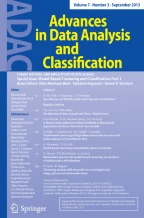Abstract
The structure of a large network (graph) can often be revealed by partitioning it into smaller and possibly more dense sub-networks that are easier to handle. One of such decompositions is based on “k-cores”, proposed in 1983 by Seidman. Together with connectivity components, cores are one among few concepts that provide efficient decompositions of large graphs and networks. In this paper we propose an efficient algorithm for determining the cores decomposition of a given network with complexity \({\mathcal{O}(m)}\), where m is the number of lines (edges or arcs). In the second part of the paper the classical concept of k-core is generalized in a way that uses a vertex property function instead of degree of a vertex. For local monotone vertex property functions the corresponding generalized cores can be determined in \({\mathcal{O}(m\cdot\max(\Delta,\log{n}))}\) time, where n is the number of vertices and Δ is the maximum degree. Finally the proposed algorithms are illustrated by the analysis of a collaboration network in the field of computational geometry.
Similar content being viewed by others
References
Ahmed A, Batagelj V, Fu X, Hong S-H, Merrick D, Mrvar A (2007) Visualisation and analysis of the internet movie database. In: Proceedings of the Asia-Pacific symposium on visualisation (APVIS2007), Sydney, NSW, Australia, 5–7 February 2007. IEEE, New York, 17–24
Alvarez-Hamelin JI, Dall’asta L, Barrat A, Vespignani A (2008) K-core decomposition of internet graphs: hierarchies, selfsimilarity and measurement biases. Netw Heterog Media 3(2): 371–393
Batagelj V, Mrvar A (2003) Pajek—analysis and visualization of large networks. In: Jünger M, Mutzel P (eds) Graph drawing software. Springer, Berlin, pp 77–103. http://pajek.imfm.si
Batagelj V (2004) Pajek datasets: Geom. http://vlado.fmf.uni-lj.si/pub/networks/Data/Collab/Geom.htm
Batagelj V, Mrvar A (2000) Some analyses of Erdős collaboration graph. Soc Netw 22: 173–186
Batagelj V, Mrvar A, Zaveršnik M (1999) Partitioning approach to visualization of large graphs. In: KratochvÍl J (ed) Proceedings of 7th international symposium on graph drawing, 15–19 September 1999, Štiřín Castle, Czech Republic (Lecture notes in computer science, vol. 1731). Springer, Berlin, pp 90–97
Batagelj V, Brandenburg FJ, Didimo W, Liotta G, Palladino P, Patrignani M (2010) Visual analysis of large graphs using (X;Y)-clustering and hybrid visualizations. In: IEEE Pacific visualization 2010 (PacVis ’10). IEEE, New YorK, pp 209–216
Beebe NHF (2002) Nelson H. F. Beebe’s bibliographies page. http://www.math.utah.edu/~beebe/bibliographies.html
Beiro MG, Alvarez-Hamelin JI, Busch JR (2008) A low complexity visualization tool that helps to perform complex systems analysis. New J Phys 10:125003, 1–18
Cormen TH, Leiserson CE, Rivest RL, Stein C (2001) Introduction to algorithms. MIT Press, Cambridge
Dorogovtsev SN, Goltsev AV, Mendes JFF (2006) k-Core architecture and k-core percolation on complex networks. Phys D Nonlinear Phenom 224(1–2): 7–19
Eisterlehner F, Hotho A, Jäschke R (eds) (2009) Proceedings of ECML PKDD discovery challenge 2009 (DC09). http://www.kde.cs.uni-kassel.de/ws/dc09/papers/proceedings.pdf
Garey MR, Johnson DS (1979) Computer and intractability. Freeman, San Francisco
Janson S, Luczak MJ (2008) Asymptotic normality of the k-core in random graphs. Ann Appl Probab 18(3): 1085–1137
Jäschke R, Marinho L, Hotho A, Schmidt-Thieme L, Stumme G (2007) Tag recommendations in folksonomies. Lecture notes in computer science, vol 4702. Springer, Berlin, pp 506–514
Jones B (2002) Computational geometry database. http://compgeom.cs.uiuc.edu/~jeffe/compgeom/biblios.html, ftp://ftp.cs.usask.ca/pub/geometry/
LaNet-vi (2009) Large network visualization tool. http://xavier.informatics.indiana.edu/lanet-vi/
Seidman SB (1983) Network structure and minimum degree. Soc Netw 5: 269–287
Schwartz J-M, Nacher JC (2009) Local and global modes of drug action in biochemical networks. BMC Chem Biol 9: 4–114
Wang J-C, Chiu C-C (2008) Recommending trusted online auction sellers using social network analysis. Expert Syst Appl Int J Arch 34(3): 1666–1679
Wasserman S, Faust K (1994) Social network analysis: methods and applications. Cambridge University Press, Cambridge
Welsh DJA, Powell MB (1967) An upper bound for the chromatic number of a graph and its application to timetabling problems. Comput J 10(1): 85–86
Wuchty S, Almaas E (2005) Peeling the yeast protein network. Proteomics 5: 444–449
Author information
Authors and Affiliations
Corresponding author
Rights and permissions
About this article
Cite this article
Batagelj, V., Zaveršnik, M. Fast algorithms for determining (generalized) core groups in social networks. Adv Data Anal Classif 5, 129–145 (2011). https://doi.org/10.1007/s11634-010-0079-y
Received:
Revised:
Accepted:
Published:
Issue Date:
DOI: https://doi.org/10.1007/s11634-010-0079-y
